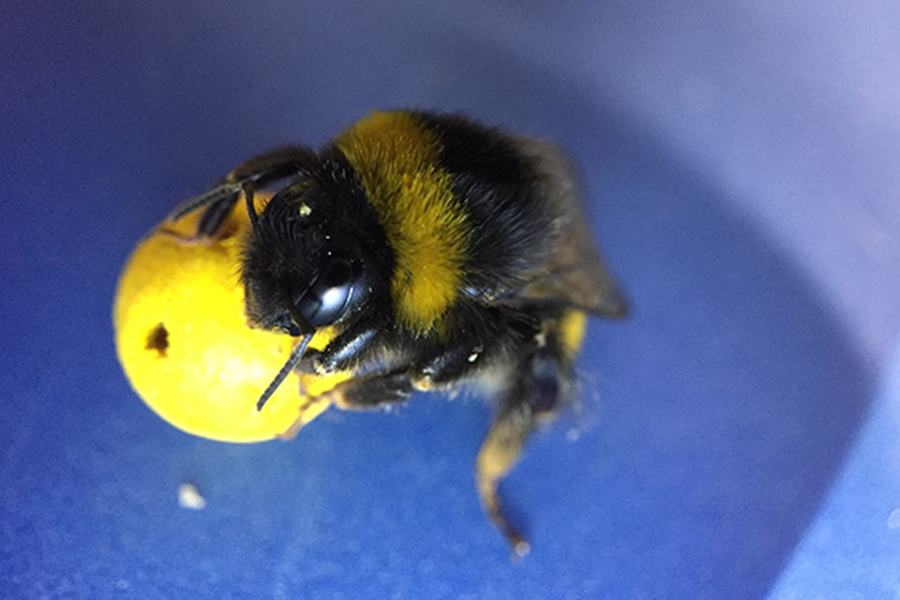How smart is a bumblebee? Smarter than you'd think, say scientists.
Loading...
It turns out you can teach an old bee new tricks. The fuzzy insects can even improve on the method, scientists say.
Bees join the ranks of tool-capable organisms, according to a paper published Thursday in the journal Science. A team of researchers from Queen Mary University of London (QMUL) showed bees to be cleverer than anyone expected, teaching them to push a ball into a goal for a sweet reward. Surprisingly, the insects’ behavior implied an abstract understanding of the simple soccer game, one that that went beyond mere mimicry.
Once considered the exclusive domain of humans, then primates, and then birds and cetaceans, tool-use has historically been thought a hallmark of highly intelligent animals. Now, bees are buzzing into the club.
"Our study puts the final nail in the coffin of the idea that small brains constrain insects to have limited behavioural flexibility and only simple learning abilities," Lars Chittka, the project supervisor, co-author, and a professor at QMUL’s School of Biological and Chemical Sciences, said in a press release.
Scientists have shown that bees can grasp the abstract concept of using an object to achieve a goal – in this case, a gulp of sugar water – even if they aren't likely to engage in such behavior in the wild.
Bees in a previous experiment succeeded in pulling a string to get their ambrosia, but since they often carry out similar tasks in the wild, such behavior could have been an extension of natural instinct. This time, researchers wanted to test whether bees could solve a problem involving a nearby object with no obvious connection to the reward.
They set up a test where a bee could land on a small table with a ball and a central hole. If the bee rolled the ball into the hole, scientists would reward it with a snack of sweet sucrose solution.
But while a few super-smart bees were able to solve the problem on their own, most needed some help. Researchers trained initial bees by using a bumblebee-decorated stick to show how to push the ball to the goal. Later bees could watch previously-trained live bee demonstrators for a chance to learn “socially.” Another group watched a “ghost” demonstration where a magnet hidden under the table dragged the ball into the hole, and a control group was presented with a ball already sitting on top of the hole.
It turns out bumblebees catch on quickly when there’s sugar involved. Rookies had three chances to watch a veteran do the trick, after which all were able to imitate the teacher. Eight out of 10 bees could learn from the magnet, while only three were able to figure out the task with no demonstration.
"It may be that bumblebees, along with many other animals, have the cognitive capabilities to solve such complex tasks, but will only do so if environmental pressures are applied to necessitate such behaviours," explained joint-lead author Olli J. Loukola in the release.
Even more impressive was how the trainees showed off their new skills. When presented with a new situation where three balls sat on the table at varying distances from the hole, seven out of 10 socially trained bees and six out of 10 “ghost”-taught bees went for the closest one, even if they had watched an experienced bee move the farthest ball during training.
From this innovation, the researchers could conclude two things: that the bees had an abstract notion of what they were doing, rather than just mindlessly following the leader; and that rolling a relatively big ball all the way across a table is tough for little bees.
"The bees solved the task in a different way than what was demonstrated, suggesting that observer bees did not simply copy what they saw, but improved on it," Dr. Loukola said.
Repeating the experiment with a black ball rather than a yellow one produced almost identical performance in trained bees, further underscoring the idea that the insects knew exactly what they were doing, in a display of what the researchers wrote was “unprecedented cognitive flexibility.”
It seems we’ve been underestimating the mental capabilities of the very small.
“The old-fashioned view is if an animal has a small brain, it’s not intelligent or smart,” Loukola told New Scientist.
Even though a bee brain has about 100,000 times fewer neurons than the one between a human's ears, it seems that in at least one simple situation they have the ability to learn and improvise a new strategy just like a person.
As the team wrote in the paper, "We present here an example in which an insect displays a goal-directed behavior for which evolution has not provided them with a rigid adaptation."
Eirik Søvik, who studies bees and animal problem-solving at Volda University College in Norway, suggests that we’re only just beginning to scratch the surface of insect cognition.
“We just have not been very good at designing experiments that allow us to probe insect cognition very well,” he told New Scientist. “That’s probably because it is so incredibly difficult to imagine how bees experience the world, and if you want to give them tasks they can succeed at, that is key. I think the authors here really succeed at taking the bees’ view of the world.”






